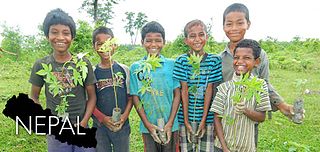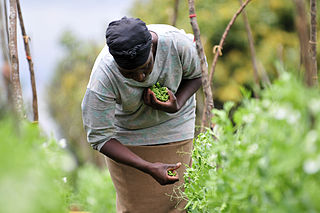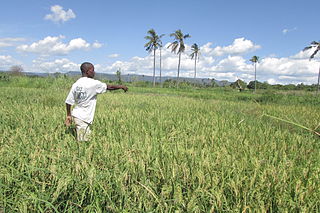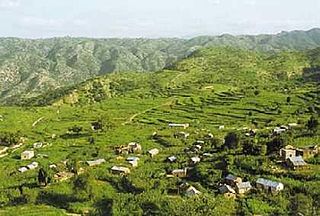The United Nations Framework Convention on Climate Change (UNFCCC) is the UN process for negotiating an agreement to limit dangerous climate change. Formally it is an international treaty among countries to combat "dangerous human interference with the climate system", in part by stabilizing greenhouse gas concentrations in the atmosphere. It was signed in 1992 by 154 states at the United Nations Conference on Environment and Development (UNCED), informally known as the Earth Summit, held in Rio de Janeiro. The treaty entered into force on 21 March 1994. "UNFCCC" is also the name of the Secretariat charged with supporting the operation of the convention, with offices on the UN Campus in Bonn, Germany.
After the 2007 United Nations Climate Change Conference held on the island of Bali in Indonesia in December 2007, the participating nations adopted the Bali Road Map as a two-year process working towards finalizing a binding agreement at the 2009 United Nations Climate Change Conference in Copenhagen, Denmark. The conference encompassed meetings of several bodies, including the 13th session of the Conference of the Parties to the United Nations Framework Convention on Climate Change and the third session of the Conference of the Parties serving as the meeting of the Parties to the Kyoto Protocol.
Tuvalu became the 189th member of the United Nations in September 2000. Tuvalu is one of 14 states not recognising the People's Republic of China. The country has played a role in advocating for more ambitious international cooperation on mitigating climate change, given the country's vulnerability to its impacts.

Saleemul Huq was a Bangladeshi-British scientist and had been the Director of the International Centre for Climate Change & Development (ICCCAD) based in Bangladesh, also Professor at Independent University, Bangladesh (IUB). He was elected one of Nature's 10 top scientists in 2022.
The Third Pole, also known as the Hindu Kush-Karakoram-Himalayan system (HKKH), is a mountainous region located in the west and south of the Tibetan Plateau. Part of High-Mountain Asia, it spreads over an area of more than 4.2 million square kilometres across nine countries, i.e. Afghanistan, Bangladesh, Bhutan, China, India, Myanmar, Nepal, Pakistan and Tajikistan, bordering ten countries. The area is nicknamed "Third Pole" because its mountain glaciers and snowfields store more frozen water than anywhere else in the world after the Arctic and Antarctic polar caps. With the world's loftiest mountains, comprising all 14 peaks above 8,000 metres (26,000 ft), it is the source of 10 major rivers, and forms a global ecological buffer.
The Copenhagen Accord is a document which delegates at the 15th session of the Conference of Parties to the United Nations Framework Convention on Climate Change agreed to "take note of" at the final plenary on 18 December 2009.
The Adaptation Fund is an international fund that finances projects and programs aimed at helping developing countries to adapt to the harmful effects of climate change. It is set up under the Kyoto Protocol of the United Nations Framework Convention on Climate Change (UNFCCC).
Local Adaptation Plans of Action (LAPAs) are community-driven plans that aim to help local governments and communities build resilience to the impacts of climate change. LAPAs are typically developed in regions or communities that are particularly vulnerable to the effects of climate change, such as areas prone to flooding, droughts, or extreme weather events.
The Kiribati Adaptation Program (KAP) is a US$5.5 million initiative that was originally enacted by the national government of Kiribati with the support of the Global Environment Facility (GEF), the World Bank, the United Nations Development Program, and the Japanese Government. Australia later joined the coalition, donating US$1.5 million to the effort. The program aims to take place over 6 years, supporting measures that reduce Kiribati's vulnerability to the effects of climate change and sea level rise by raising awareness of climate change, assessing and protecting available water resources, and managing inundation. At the start of the Adaptation Program, representatives from each of the inhabited atolls identified key climatic changes that had taken place over the past 20–40 years, and proposed coping mechanisms to deal with these changes under 4 categories of urgency of need. The program is now focusing on the country's most vulnerable sectors in the most highly populated areas. Initiatives include improving water supply management in and around Tarawa; coastal management protection measures such as mangrove re-plantation and protection of public infrastructure; strengthening laws to reduce coastal erosion; and population settlement planning to reduce personal risks.

Climate change is a critical issue in Bangladesh as the country is one of the most vulnerable to the effects of climate change. In the 2020 edition of Germanwatch's Climate Risk Index, it ranked seventh in the list of countries most affected by climate calamities during the period 1999–2018. Bangladesh's vulnerability to the effects of climate change is due to a combination of geographical factors, such as its flat, low-lying, and delta-exposed topography, and socio-economic factors, including its high population density, levels of poverty, and dependence on agriculture. The impacts and potential threats include sea level rise, temperature rise, food crises, droughts, floods, and cyclones.

Climate change in Africa is an increasingly serious threat as Africa is among the most vulnerable continents to the effects of climate change. Some sources even classify Africa as "the most vulnerable continent on Earth". Climate change and climate variability will likely reduce agricultural production, food security and water security. As a result, there will be negative consequences on people's lives and sustainable development in Africa.

Climate finance is an umbrella term for funding investments in the area of climate change mitigation and adaptation. In a wider sense, the term refers to all financial flows relating to climate change mitigation and adaptation. In a narrower sense it only refers to transfers of public money from developed countries to developing countries. This would be in light of their obligations under the UN Climate Convention to provide new and additional financial resources.
The Scientific and Technical Advisory Panel (STAP) is an independent advisory body established by the United Nations Global Environment Facility (GEF) in 1995. Seven expert advisers provide the GEF with up to date, authoritative and globally representative science in the areas of biological diversity, climate change, desertification and persistent organic pollutants.

Globally, Nepal is ranked fourth in terms of vulnerability to climate change. Floods spread across the foothills of the Himalayas and bring landslides, leaving tens of thousands of houses and vast areas of farmland and roads destroyed. In the 2020 edition of Germanwatch's Climate Risk Index, it was judged to be the ninth hardest-hit nation by climate calamities during the period 1999 to 2018. Nepal is a least developed country, with 28.6 percent of the population living in multidimensional poverty. Analysis of trends from 1971 to 2014 by the Department of Hydrology and Meteorology (DHM) shows that the average annual maximum temperature has been increasing by 0.056 °C per year. Precipitation extremes are found to be increasing. A national-level survey on the perception-based survey on climate change reported that locals accurately perceived the shifts in temperature but their perceptions of precipitation change did not converge with the instrumental records. Data reveals that more than 80 percent of property loss due to disasters is attributable to climate hazards, particularly water-related events such as floods, landslides and glacial lake outburst floods (GLOFs).

Climate change affects men and women differently. Climate change and gender examines how men and women access and use resources that are impacted by climate change and how they experience the resulting impacts. It examines how gender roles and cultural norms influence the ability of men and women to respond to climate change, and how women's and men's roles can be better integrated into climate change adaptation and mitigation strategies. It also considers how climate change intersects with other gender-related challenges, such as poverty, access to resources, and unequal power dynamics. Ultimately, the goal of this research is to ensure that climate change policies and initiatives are equitable, and that both women and men benefit from them. Climate change increases gender inequality, reduces women's ability to be financially independent, and has an overall negative impact on the social and political rights of women, especially in economies that are heavily based on agriculture. In many cases, gender inequality means that women are more vulnerable to the negative effects of climate change. This is due to gender roles, particularly in the developing world, which means that women are often dependent on the natural environment for subsistence and income. By further limiting women's already constrained access to physical, social, political, and fiscal resources, climate change often burdens women more than men and can magnify existing gender inequality.
The Sopoaga Ministry was the 14th ministry of the Government of Tuvalu, led by Prime Minister Enele Sopoaga. It succeeds the Telavi Ministry upon its swearing in by Governor-General Sir Iakoba Italeli on 5 August 2013.

Action for Climate Empowerment (ACE) is a term adopted by the United Nations Framework Convention on Climate Change (UNFCCC). It refers to Article 6 of the Convention's original text (1992), focusing on six priority areas: education, training, public awareness, public participation, public access to information, and international cooperation on these issues. The implementation of all six areas has been identified as the pivotal factor for everyone to understand and participate in solving the complex challenges presented by climate change. The importance of ACE is reflected in other international frameworks such as the Sustainable Development Goals ; the Global Action Programme for Education for Sustainable Development ; the Aarhus Convention (2011); the Escazú Agreement (2018) and the Bali Guidelines (2010).

Climate change in Tanzania is affecting the natural environment and residents of Tanzania. Temperatures in Tanzania are rising with a higher likelihood of intense rainfall events and of dry spells.
Ecosystem-based adaptation (EBA) encompasses a broad set of approaches to adapt to climate change. They all involve the management of ecosystems and their services to reduce the vulnerability of human communities to the impacts of climate change. The Convention on Biological Diversity defines EBA as "the use of biodiversity and ecosystem services as part of an overall adaptation strategy to help people to adapt to the adverse effects of climate change".

Eritrea is a small coastal nation situated along the Red Sea in the Horn of Africa. It shares borders with Sudan, Ethiopia, and Djibouti. The country spans a total land area of 124,300 square kilometers and boasts a coastline extending 1,900 kilometers. Eritrea's territorial waters in the Red Sea zone comprise approximately 120,000 square kilometers. It possesses diverse eco-geographic regions that provide unique habitats for both marine and terrestrial flora and fauna. Eritrea is one of the most vulnerable countries of the world to the adverse effects of climate change and increased climate variability has already been evidenced in the country.








